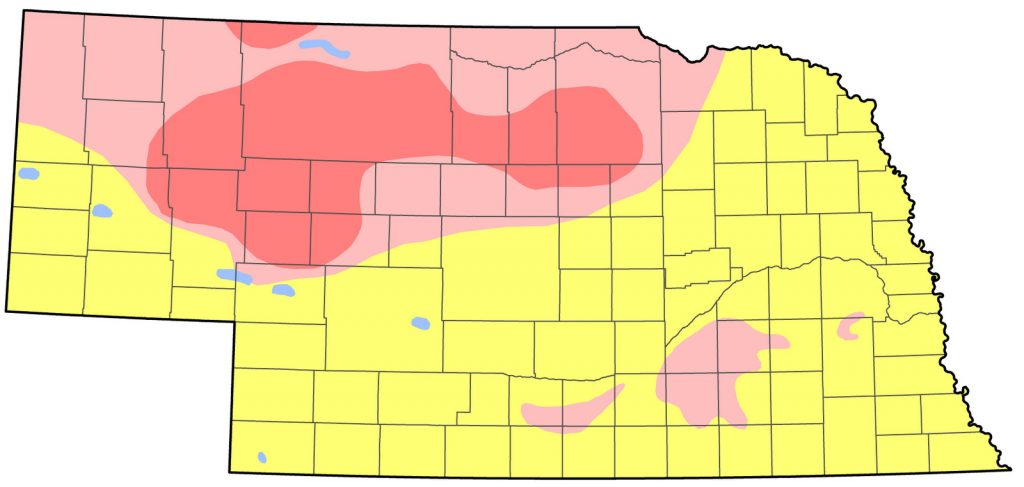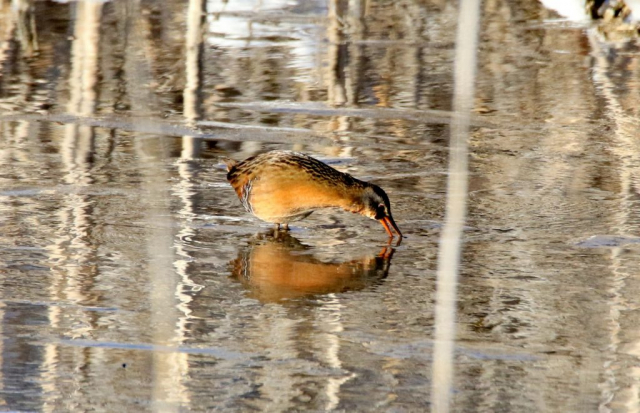Rallus limicola limicola
Status: Uncommon regular spring and fall migrant east and west, common central. Uncommon, locally common, regular breeder north and west, rare south and east. Uncommon local regular winter visitor west and central, rare casual elsewhere.
Documentation: Specimen: UNSM ZM6100, 14 Jun 1902 Marsh Lake, Cherry Co.
Taxonomy: Traditionally four subspecies, but two South American subspecies recently split as Ecuadorian Rail, based on vocalizations (Gill et al 2024). Subspecies retained in Virginia Rail are limicola of southern Canada and the United States, and friedmanni of south-central and southeast Mexico (AviList 2025).
Nebraska birds are limicola.
Spring: Mar 28, 31, Apr 2 <<<>>> Jun 12, 14, 15 (away from breeding and winter ranges)
Arrival of migrants is expected in early to mid-Apr, with a peak late Apr-early May. Numerous reports in Mar are probably birds that wintered (see Winter), and so it is difficult to determine the arrival dates for spring migrants. Determination of late dates for spring migration is difficult due to possible breeding birds; May and Jun dates are suggestive of breeding.
- High counts: 14 at Wood Duck WMA, Stanton Co 3 May 2020, 10 at Kiowa WMA, Scotts Bluff Co 11 May 2022, 10 at Valentine, Cherry Co 17 May 2022, 8 at Lincoln Saline Wetlands Nature Park, Lancaster Co 3 May 2019, and 7 at Clear Creek WMA, Keith and Garden Cos 23 Apr 1977 (Rosche 1994).
Summer: Breeding is generally confined to the state’s major wetland complexes; highest breeding densities occur in the Sandhills. Jorgensen et al (2022) noted that Virginia Rail was “by far” the most abundant species detected in the Sandhills in a 2016-2017 survey of “secretive marsh birds”. At the south edge of the Sandhills, two adults with nine young were along Washboard Road, Lincoln Co 28-29 Jun 2023; at least one adult and three young were still there 5 Jul.
In the southwest there are reports from Dundy Co 2-12 Jun in 1992-2005, 2 Jun 1992 Chase Co, 2 Jun 2003 at Hayes Center WMA, Hayes Co, and 17 Jul 2003 near Brady, Lincoln Co. There is an observation of an adult with downy young just west of Sutherland Reservoir in Lincoln Co 9 Aug 1987.
Even though it may be an expected breeder in the Rainwater Basin, breeding records are surprisingly few (Jorgensen 2012), suggestive of irregular breeding. Secretive marsh bird surveys conducted in 2016-2017 yielded only 12 Virginia Rail detections (Jorgensen et al 2022). However, surveys in 2021 found good numbers, with 60+ tallied at 13 sites and a best count of 14 at Mallard Haven WPA, Fillmore Co 2 Jul. In the 2016-2017 study, Virginia Rail was abundant in the Sandhills and virtually absent in the Rainwater Basin (respective detections 255 vs 12), in contrast with Sora, which was common in the Rainwater Basin and less common in the Sandhills (respective detections 171 vs 47). Jorgensen et al (2022), noting that the two species have different diets, Virginia Rail preferring an insect diet and Sora preferring seeds, suggested that annual plants such as Smartweeds (Polygonum spp.) may be more plentiful in the Rainwater Basin as a result of more dynamic wetlands and moist soil management practices specifically intended to increase seed food resources for migratory waterfowl. Higher levels of agricultural chemicals in Rainwater Basin wetlands likely occur due to runoff, notably neonicotinoids, which negatively impact invertebrates and thus would reduce that food source for Virginia Rail (Jorgensen et al 2022).
The three confirmed Rainwater Basin breeding records are of two adults and four young at Funk WPA, Phelps Co 4 Jul 1998, an adult with three chicks at Waco WPA, Seward Co 12 Jul 2007, and adults with downy young at Tamora WPA, Seward Co 30 Aug-7 Sep 2008. There are several additional nesting season reports in the Rainwater Basin. As well as the breeding record cited above for Funk WPA, there are reports there 17-19 May and 30 Jun 1996, 19 Jul 2003, 9 Jul 1995, and 30 Jul 2000. Elsewhere, reports are concentrated in the vicinity of Waco, York Co: 15 Jun 2014 Spikerush WMA, 20 Jun 2005 Waco WPA, 5 Jul 2003 Sinninger WPA, and 19 Jul 2003 Heron WPA (Jorgensen 2012).
There are a few breeding records in the east: a nest with eggs at Waterloo, Douglas Co 25 May 1968 (Holcomb, Cornell Nest Record Program #41; Mollhoff 2022), 1972 and 1984 in Lancaster Co (Ducey 1988; Cink 1975), 1982 in Douglas Co (Bennett 1983), a nest with eggs in 1995 at Jack Sinn WMA, Lancaster Co (Joseph Gubanyi, personal communication), a chick photographed east of Creighton, Knox Co 26 Aug 2018, and a fledged juvenile at Lincoln Saline Wetlands NP, Lancaster Co 17 Jun 2024.
In addition, there are several nesting season reports in the east: three on 6 Jun 1998 Crystal Cove Lake, Dakota Co, Jun-Jul 1968 and 6 Jul 1984 Douglas-Sarpy Cos, 2 Jun 1999, 14 Jun 1983, 1-20 Jul 1970, and 23 Jul 1988 Lancaster Co, 8-9 Jun 2005 Stanton Co, 19 Jun 2008 Thurston Co, and 20 Jun 1987 Pierce Co. The only site where Dinan et al (2018) detected the species in 2016-17 in the eastern saline wetlands of northern Lancaster and southern Saunders counties was Little Salt Fork Marsh, Lancaster Co, the same location where Dinan and Jorgensen (2015) detected the species in 2013.
There are only two summer reports from the Panhandle south of Sioux Co, 17 Jun 1980 and 11 Jul 1985 in Scotts Bluff Co.
Airboat surveys for waterfowl in 2022 yielded tallies of 15 at Yellowthroat WMA, Brown Co on both 1 and 28 Jul and 13 at Valentine NWR 29 Jul (Gabriel Runyon, eBird.org).
- Breeding Phenology:
Eggs: 14 May- 15 Jul (Mollhoff 2022)
Fledglings: 30 May-29 Aug
Fall: Aug 17, 18, 20 <<<>>> Oct 12, 13, 13 (away from breeding and winter ranges)
It is difficult to determine early fall migration dates due to lingering occurrence of summering birds. Dispersal may begin in Jul and early Aug; dispersal of radio-tracked adults away from breeding locations occurred 19 Jul-1 Aug in Iowa (Johnson and Dinsmore 1985). Juveniles at different sites in Lancaster Co 30 Jul 2016 and 31 Jul 2016 may have been migrants, as may have been one in Dakota Co 24 Jul 2019. Five and four responding from two areas of cattails in Keith Co 6 Aug 2017 may have been local family groups or migrants. There are eight records away from the breeding range 16 Jun-16 Aug.
Last dates above correspond with a drop off in fall records; most leave by late Sep, as there are few Oct reports and later birds are presumably attempting to winter (see Winter). Later reports are mostly along the North Platte River Valley, but elsewhere there are these that may be late migrants: 14-15 Oct 2009 Dawes Co, 19 Oct 2020 two Kimball Co, 20 Oct-7 Nov 2005 Lincoln Co, 20 Oct 2023 Douglas Co, 23 Oct 1982 Hamilton Co, 24 Oct 2013 Douglas Co, 26 Oct 2004 Dundy Co, and 27 Oct 2013 Lancaster Co. One photographed wandering around downtown Wahoo, Saunders Co streets 7 Nov 2019 was probably forced out as its habitat froze.
It is difficult to assess fall arrival and peak migration timing. That large numbers may stage at times is indicated by a post-breeding estimate of 5000 in Aug 1977 at Crescent Lake NWR, Garden Co that “boggles the mind” (Williams 1978).
Winter: In recent years, it has become clear that this species winters regularly in the North Platte River Valley and the central Niobrara River Valley. There are multiple reports from Kiowa WMA, Scotts Bluff Co, Chet and Jane Fleisbach WMA, Morrill Co, southeastern Garden Co, Lake McConaughy, Keith Co, and Hiatt Wetlands, Lincoln Co. In winter 2004-2005 a search along the Niobrara River located about four single birds at four locations in Cherry Co from Merriman east to NNF McKelvie, Cherry Co; two were found in the same area 10 Jan 2006 (Ducey 2007), and one was heard at Valentine NWR, Cherry Co 9 Mar 2020. Several were attracted to a recording along Snake River Road, Cherry Co 29 Nov 2024 and seven were heard there 3 Dec 2024.
Additional records from areas where wintering might occur are: 2 Nov 2020 Enders Reservoir, Chase Co, 6 Nov 2009 Dundy Co, 24 Nov and 23-24 Dec 2020 Nuckolls Co, 1 Dec 1996 Crescent Lake NWR, Garden Co, 14 Dec 2003 Chester Island WMA, Lincoln Co, 19 Dec 1997 Boone Co CBC, 5 Mar 2000 Funk WPA, Phelps Co, 5 Mar 2023 Kearney, Buffalo Co, two on 18 Mar 2018 on Blue Creek, Garden Co, singles 19 Feb 2022 and 23 Mar 2019 Kimball Co, 24 Mar 1992 Sioux Co, and 30 Mar 2011 Wind Springs Ranch, Sioux Co.
- High counts: 16 at Facus Springs 10 Jan 1999, 10 near Lewellen 22 Feb 1998, 9 at Clear Creek WMA 5 Feb 2000, 8 at Spring Park, Lake McConaughy, Keith Co 18 Sep 2024, and 7 at Garden County Wildlife Refuge, Garden Co 23 Mar 2020.
Images
Abbreviations
CBC: Christmas Bird Count
NNF: Nebraska National Forest
WMA: Wildlife Management Area (State)
WPA: Waterfowl Production Area (Federal)
UNSM: University of Nebraska State Museum
Literature Cited
AviList Core Team, 2025. AviList: The Global Avian Checklist, v2025. https://doi.org/10.2173/avilist.v2025.
Bennett, E.V. 1983. 1982 Nebraska nesting survey. NBR 51: 26-32.
Cink, C.L. 1971. Some interesting summer bird records for Lancaster County in 1970. NBR 39: 58-59.
Dinan, L.R., M. Bomberger Brown and J.G. Jorgensen. 2018. 2016-2017 Secretive marshbird abundance, distribution and habitat use in Nebraska. Joint report of the Nongame Bird Program of the Nebraska Game and Parks Commission and Tern and Plover Conservation Partnership, Lincoln, Nebraska, USA.
Dinan, L.R., & J.G. Jorgensen. 2014. 2013 Secretive Marshbird Survey of Nebraska’s Eastern Saline Wetlands. Nongame Bird Program of the Nebraska Game and Parks Commission, Lincoln, Nebraska, USA.
Ducey, J.E. 1988. Nebraska birds, breeding status and distribution. Simmons-Boardman Books, Omaha, Nebraska, USA.
Ducey, J.E. 2007. Water Habitats a Refugium for Winter Birds Along the Central Niobrara River. Wildbirds Broadcasting blog, accessed 20 February 2018.
Gill, F., D. Donsker, and P. Rasmussen (Eds). 2024. IOC World Bird List (v 14.2). Doi 10.14344/IOC.ML.14.2. http://www.worldbirdnames.org/.
Johnson, R. R. and J. J. Dinsmore. 1985. Brood-rearing and postbreeding habitat use by Virginia Rails and Soras. Wilson Bulletin 97: 551-554.
Jorgensen, J.G. 2012. Birds of the Rainwater Basin, Nebraska. Nebraska Game and Parks Commission, Lincoln, Nebraska, USA.
Jorgensen, J.G. 2016. A summary of 2015 breeding bird surveys of selected Rainwater Basin wetlands. Nongame Bird Program of the Nebraska Game and Parks Commission, Lincoln, Nebraska, USA.
Jorgensen, J.G., S.J. Brenner, and L.R. Greenwalt. 2022. A Tale of Two Complexes: Secretive Marsh Bird Abundance Differs in the Sandhills and Rainwater Basin, Nebraska. Wetlands 42: 41 https://doi.org/10.1007/s13157-022-01551-9./p
Mollhoff, W.J. 2022. Nest records of Nebraska birds. Nebraska Ornithologists’ Union Occasional Paper Number 9.
Rosche, R.C. 1994. Birds of the Lake McConaughy area and the North Platte River valley, Nebraska. Published by the author, Chadron, Nebraska, USA.
Williams, F. 1978. Southern Great Plains Region. American Birds 32: 223-227.
Recommended Citation
Silcock, W.R., and J.G. Jorgensen. 2025. Virginia Rail (Rallus limicola limicola). In Birds of Nebraska — Online. www.BirdsofNebraska.org
Birds of Nebraska – Online
Updated 21 Jul 2025

